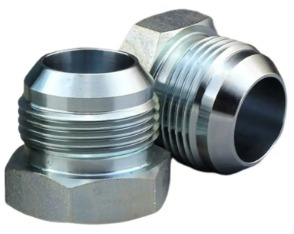Welcome to our comprehensive guide on JIC cap and plug kits. In this article, we will unravel the complexities surrounding these essential components of hydraulic systems. Whether you’re a novice or an expert in the field, this article promises to enhance your knowledge about JIC fittings, focusing on the key aspects of JIC cap and plug kits.
What Does JIC Stand For in Fittings? Decoding the Acronym
JIC, or Joint Industry Council, is a term you often encounter in the realm of hydraulic fittings. Understanding the acronym is crucial to grasping the significance of JIC cap and plug kits. The Joint Industry Council has set standards for hydraulic fittings, ensuring uniformity and compatibility across various systems. The term “JIC” signifies a level of quality and reliability that is indispensable in hydraulic applications.
The Most Common JIC Fitting: Exploring the Standard Choice
JIC Male 37° Cone Plug
Among the myriad of hydraulic fittings available, the 37-degree JIC fitting stands out as one of the most common choices. Its universal appeal can be attributed to its excellent sealing capabilities and straightforward installation process. The 37-degree flare angle ensures a secure connection, making it ideal for high-pressure applications. If you’re looking for a fitting that combines durability, ease of use, and reliability, the 37-degree JIC fitting is your go-to option.
FAQs: Answering Your Burning Questions About JIC Cap and Plug Kits
1. What Is the Significance of the 37-Degree Flare Angle in JIC Fittings?
The 37-degree flare angle in JIC fittings plays a pivotal role in ensuring a leak-free connection. This specific angle maximizes the surface contact between the fitting and the flare, enhancing the seal’s integrity. It’s a design choice aimed at providing optimal performance and safety in hydraulic systems.
2. Can I Use JIC Cap and Plug Kits for High-Pressure Hydraulic Systems?
Absolutely! JIC cap and plug kits, particularly those featuring the 37-degree flare angle, are engineered to handle high-pressure hydraulic systems with ease. Their robust construction and precise design make them suitable for applications where pressure integrity is paramount.
3. Are JIC Cap and Plug Kits Compatible with Different Types of Hydraulic Fluids?
Yes, JIC cap and plug kits are designed to be compatible with a wide range of hydraulic fluids. Whether you’re working with mineral oils, synthetic fluids, or water-based solutions, JIC fittings ensure reliable performance. This versatility makes them a preferred choice in diverse hydraulic applications.
4. How Do I Identify a JIC Cap and Plug Kit Among Various Hydraulic Fittings?
Identifying a JIC cap and plug kit is relatively straightforward. Look for the characteristic 37-degree flare on the fitting’s end. Additionally, many JIC fittings are marked with specifications, making it easier for users to distinguish them from other types of hydraulic fittings.
5. Can JIC Cap and Plug Kits Be Reused?
JIC cap and plug kits can be reused, but it’s crucial to inspect them thoroughly before reinstallation. Check for signs of wear, damage, or deformation. If the fitting shows any compromise in its integrity, it’s advisable to replace it to maintain the system’s efficiency and safety.
6. Are There Different Sizes Available for JIC Cap and Plug Kits?
Yes, JIC cap and plug kits come in various sizes to accommodate different hydraulic system requirements. From smaller fittings suitable for intricate setups to larger ones designed for heavy-duty applications, there’s a diverse range of sizes available in the market.
Conclusion: Mastering the Essentials of JIC Cap and Plug Kits
In conclusion, understanding the nuances of JIC cap and plug kits is vital for anyone working with hydraulic systems. By delving into the specifics of what JIC stands for in fittings and exploring the most common JIC fitting, you’re equipped with the knowledge needed to make informed decisions in your hydraulic applications. Remember, the right fitting not only ensures optimal performance but also contributes significantly to the safety and efficiency of your hydraulic systems.
Post time: Dec-01-2023


